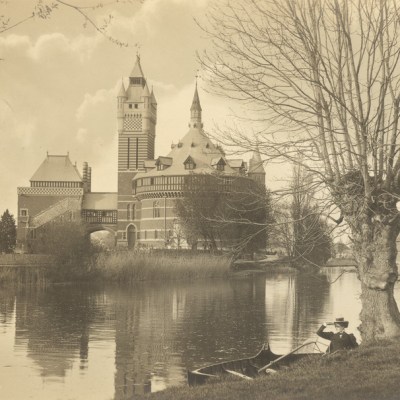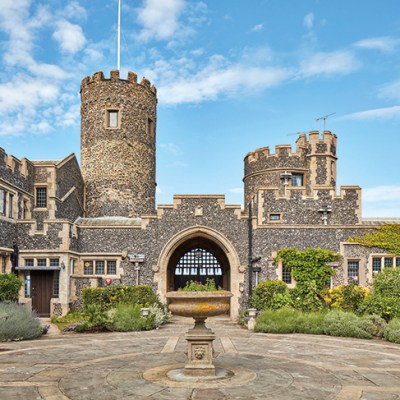
From the April 2024 issue of Apollo. Preview and subscribe here.
Gavin Stamp’s magisterial conspectus of architecture in Britain between the wars opens with an image of a dead artilleryman shrouded by a tarpaulin. The bronze sculpture features on Charles Sargeant Jagger’s Royal Artillery Memorial of 1925 at Hyde Park Corner, one of the more affecting public commemorations of the Great War.
He concludes with the house Serge Chermayeff designed for himself in Sussex, which possessed intimations of ‘a modern form of Englishness’, including a Henry Moore in the garden, and was completed in 1938. The ‘new architecture’ of modernism was still the shape of things to come, but then came the small matter of another world war.
However, Stamp is much less beguiled by past visions of the future and the conventional narrative of modernism being seeded in England’s damp and unpleasant land by émigrés, radicals and misfits. Although modernism is part of the picture, he prefers to lift the historical bonnet on the at times exuberant, at times turgid gallimaufry of the interwar decades, a milieu that has, in his view, either been glossed over or simply ignored by the devotees of modernism. A quick glance at the index of Interwar conveys its author’s eclecticism: under ‘F’, there is Fascism; Faubourg d’Amiens Cemetery; Fields, Gracie; Findhorn Bridge, Scotland; Finsbury Health Centre and Firestone Factory.
After the horrors of the First World War, the period that followed was as much about looking wistfully backwards as embracing the future. It was the era of the Cenotaph and Jazz Age ‘fancy factories’; of power stations and neo-Georgian townhouses; of Tudorbethan semis and the radical possibilities of plate glass and concrete. The centre could not hold. Social structures fragmented, economies collapsed, technology advanced and art movements coalesced as the nation attempted to regroup.
Commemorating the war dead became a grim mass industry, with a memorial dispatched to practically every town and village across the land, as well as overseas. ‘The total loss for the British Empire was well over a million,’ Stamp notes. ‘Such figures transcend ordinary comprehension; in one contemporary Armistice Day broadcast, the enormity of the loss was illustrated by stating that if all the Britons killed in the Great War were to march four abreast from Scotland to London, by the time the leaders reached Whitehall the tail of the column would still be at Durham.’
The war created a vast gulf between generations. Stamp writes that this atmosphere of unease and loss of confidence was in part responsible for the architectural disparity and confusion of the period. Ultimately, it also impelled the technological and social progressiveness of the modern movement. But for a time, Victorian and Edwardian mastodons, such as Reginald Blomfield and Herbert Baker, lumbered on, bellowing at each other across the blasted plain of the 1920s.
In 1927, the publication of Frederick Etchells’s English translation of Le Corbusier’s Vers une Architecture offered a glimpse of new possibilities to an emerging generation of architects. But while the Continent might have been in thrall to Corb, Britain had Oliver Hill, designer of the suavely streamlined Midland Hotel in Morecambe and, as Stamp points out, ‘an exact contemporary’ of Le Corbusier, born in 1887. Like many of his time, Hill deftly turned his hand to a multiplicity of styles, from the ‘flat-roofed Bolshevism’ of nascent Modernism to neo-Georgian and neo-Regency.
Stamp clearly relishes this plurality. Along with diligent scrutiny of the era’s default neo-classicism and the tempering influences of Sweden and the United States, he also sets off for wilder stylistic shores. There are chapters on Egyptomania, set in train by the discovery of Tutankhamun’s tomb in 1922, as well as the neo-Tudor so beloved of England’s stockbroker belt but also seemingly hardwired into the national psyche.
Stamp’s affectionate exhumation of ‘Merrie England’ begins with a meditation on the half-timbered retail palace of Liberty & Co.‘constructed out of teak and oak taken from two old naval warships’ in 1924 and continues with characters who could be out of the pages of P.G. Wodehouse. We meet C.H. Biddulph-Pinchard, who scavenged bricks from demolished houses to create a neo-Tudor summer residence in Sandwich, patronised by the Prince of Wales; Blunden Shadbolt specialised in deliberately wonky houses, laying roof tiles on chicken wire to replicate the antique effects of weathered age – ‘truth to materials’ of a rather different kind.
The posthumous publication of Interwar is a fitting memorial to Stamp, who died at the end of 2017, at the age of 69, following a stellar career as an architectural historian, journalist and critic. Drawn into the orbit of the Architectural Review, he became close to John Betjeman and in 1978, on Betjeman’s recommendation, assumed the role of Private Eye’s ‘Piloti’, acerbic scourge of environmental malefactors, ‘individual or municipal’. (He was also Apollo’s architecture columnist for more than a decade.)
Sartorially fogeyish, though his background was much less so, Stamp was a man, as his friend the journalist Ian Jack put it, ‘untouched by the age of denim’. You sensed he would have been right at home chez Shadbolt, but he was also a doughty activist and campaigner. In 1979, he helped establish the Thirties Society and was its chairman for the next 20 years as it evolved into the Twentieth Century Society, which supported the publication of Interwar, enabling Stamp’s lucid prose to be accompanied by a series of superb images, many specially taken by John East or drawn from the photographer’s archive.
Time inevitably grants perspective, so this is a book that could have been written only at the point when events and their consequences have played out, their dramatis personae long gone. In untangling the threads of a period of unimaginable change and stubborn constancy, Stamp is a forensic and sympathetic chronicler. You wish he were still on the stage. But in Interwar he has left behind the work of a lifetime.
Interwar: British Architecture 1919–39 by Gavin Stamp is published by Profile Books.
From the April 2024 issue of Apollo. Preview and subscribe here.



